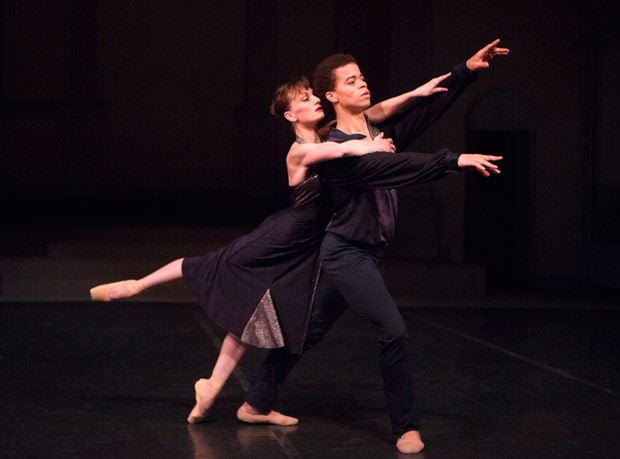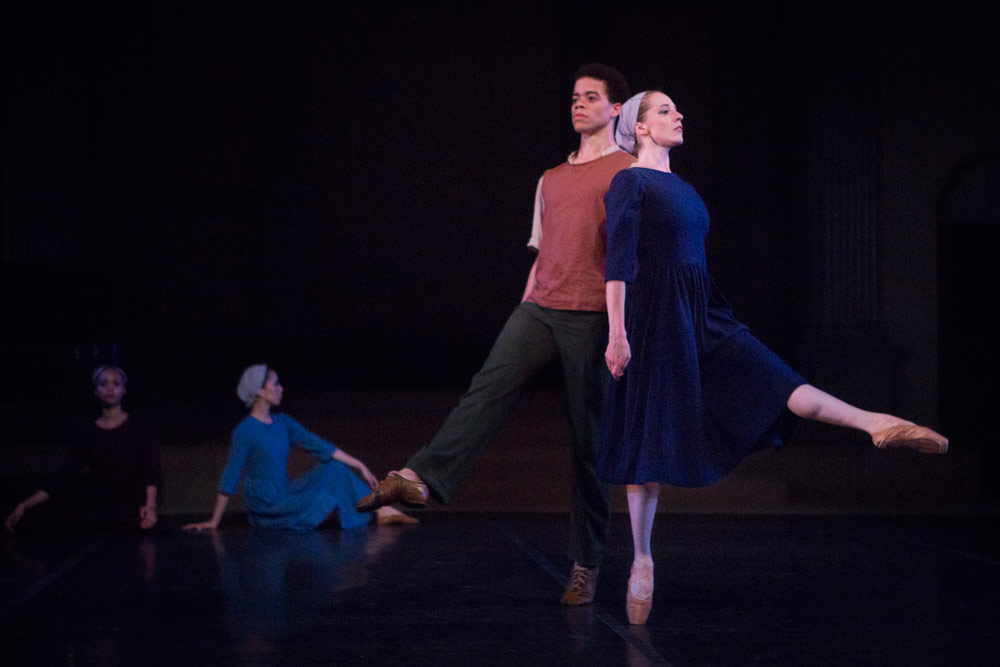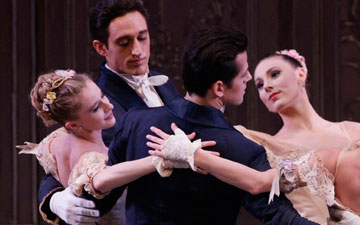
© Yi-Chun Wu. (Click image for larger version)
New York Theatre Ballet
Capriol Suite, Two Timing, Cat’s Cradle, Such Longing, Dark Elegies
New York, St. Mark’s Church
19 June 2015
www.nytb.org
In the Place Just Right
Since decamping from Murray Hill for the East Village, the small chamber company New York Theatre Ballet has undergone a subtle transformation. Maybe it’s just a question of feeling inspired by new surroundings. They’re now based in an episcopal church complex that also serves as the headquarters for Danspace’s experimental-dance series. The slight grimness that accompanied some of Theatre Ballet’s appearances uptown at the underground Florence Gould Hall has lifted. Last week’s performances in the sanctuary of St. Mark’s Church felt just right.
The company of twelve is devoted to the performance of small-scale works, with live musical accompaniment when possible. Its director, Diana Byer has an affinity with the ballets of Frederick Ashton, Agnes de Mille and Anthony Tudor. (The dancers’ technique, as well as the children’s classes taught upstairs, is based on the Cecchetti syllabus, with an emphasis on coordination of the head and shoulders, the use of the eyes, and subtle musicality.) More recently, and much to the company’s advantage, Byer has developed a relationship with the British modern-dance choreographer Richard Alston. He discovered them almost by chance a few years back when his company was on tour in the United States. Alston was moved by the way they performed Tudor, “with extraordinary simplicity.” This has led to his making new works for the company, reviving others, and, surely, enhancing the dancers’ performances in the rest of the repertory.

© Yi-Chun Wu. (Click image for larger version)
Byer seems increasingly interested in presenting new choreography, particularly by women choreographers. She has cultivated the work of Pam Tanowitz and Gemma Bond, and, more importantly, she has stuck with them, allowing them second and third chances.
The program presented at St. Mark’s this past week reflects all of these positive developments; even more, it seemed infused with a new sense of assurance and identity. It consisted of five works: Ashton’s Capriol Suite; Two Timing, by David Parker; Cat’s Cradle, an octet by Gemma Bond; Richard Alston’s re-vamped and expanded Such Longing; and Tudor’s Dark Elegies.

© Yi-Chun Wu. (Click image for larger version)
One of the most pleasing aspects of the evening was the use of live music (piano and voice). The sound filled the church’s interior like a physical presence, augmenting the impact of the dances. This was particularly true in Dark Elegies, which is set to Mahler’s Kindertotenlieder song-cycle, arranged for piano and baritone. I can’t comment on the singer – Darren Chase, a friend – but I can say that the weeping, desolate character of the songs seemed to enclose the dancers in a wall of sadness. This, combined with the plainness of Tudor’s language of straight arms, blank faces, angular poses and sudden falls, made for a particularly powerful performance.
The church setting seemed apt. For the first time I imagined the whole ballet – a lament for lost children – as a kind of Shaker ritual, a gathering-together to mourn and find solace over the course of a single long night. The dancers perform the work gravely, without excess of emotion. Given the recent church murders in Charleston, the theme of communal grief and consolation through faith felt particularly poignant.

© Yi-Chun Wu. (Click image for larger version)
Dark Elegies was the final work in an evening that had begun with Ashton’s charming Capriol Suite. The choreographer’s earliest surviving work (from 1930) is set to piano-four-hands pieces by Peter Warlock inspired by 16th century Elizabethan tunes, jauntily-played by Michael Scales and Zheng Ma. The suite of dances, also loosely inspired by Elizabethan forms, both courtly and popular, exhibits Ashton’s typical wit, sense of measure, and sharpness of characterization. The footwork, executed in low-heeled shoes, is rhythmic and crisply accented. Nothing is overstated or exaggerated. The dancers’ gazes guide our attention to subtle interactions, particularly during a trio for a lady courted by two men, one holding a rose, the other, a poem. (It was danced with elegance and poise by Amanda Treiber, Steven Melendez and Michael Wells.) A whole world of courtly intrigue and secrets was suggested in just a few glances and gestures.
This was followed by two new works, David Parker’s Two Timing, and Cat’s Cradle, by Gemma Bond. The central device of the latter was the linking-together of the dancers with ribbons to create knotty patterns and obstacles to step over or under. It wore thin rather quickly. In Two Timing, a dancer in purple pointe shoes (Elena Zahlmann) tapped out a conversation with a man (Jeffrey Kazin) clapping the tricky twelve-beat phrases of Steve Reich’s Clapping Music. The two, thick as thieves, finished each other’s sentences and bounced ideas back and forth with a conspiratorial air. Though the rhythms were not always as crisp as one might hope for in such an experiment, it was intriguing to hear the range of sounds that can be produced with a pointe shoe. The idea is clever.

© Yi-Chun Wu. (Click image for larger version)
Alston’s Such Longing, a revised and extended version of a 2005 piece for his own company, came next. Like Robbins’ Dances at a Gathering and In the Night, it is set to Chopin piano pieces, here sensitively played by Michael Scales. Alston responds less vividly to the music’s Slavic feel than Robbins did, though he has included a few flourishes, like a turning mazurka step for Steven Melendez, the company’s most striking dancer. The dance – a quartet – is really an homage to Melendez’s quietly heroic presence, his modesty and the clean power of his dancing. It begins and ends with a solo for Melendez, marked by large, weighty, grounded movements; each solo ends with a very slight, dignified bow, just from the shoulders.
In between there are three duets, two for a man and a woman, one for two men. The first, for Melendez and Amanda Treiber, has a theme of falling, as well as an Orpheus-like image in which Melendez carries Treiber forward on his back. It is lovely, and, characteristically for Alston, deeply musical. The second, for Choong Hoon Lee and Rie Ogura, is more turbulent, and less interesting. The section for two men is filled with buoyant jumps, a welcome release after so much contained dancing over the course of the evening.

© Yi-Chun Wu. (Click image for larger version)
It’s good to see the dancers in such fine fettle, and, finally, in a space that allows them to really move. They seem, happily, to have found a home.

















You must be logged in to post a comment.